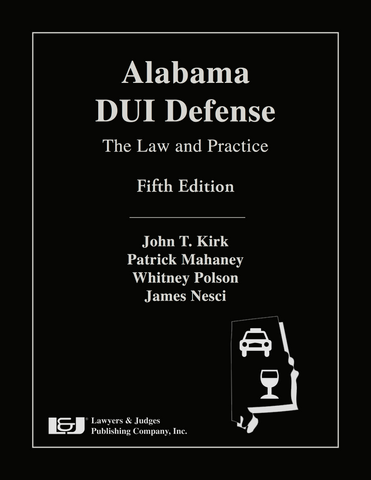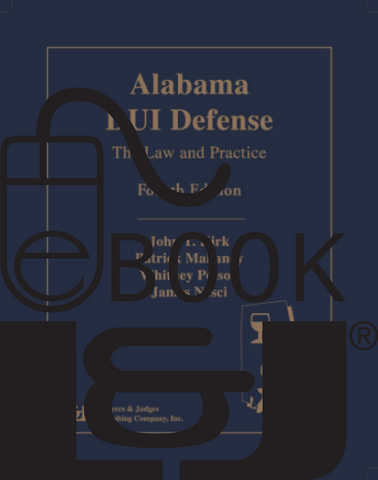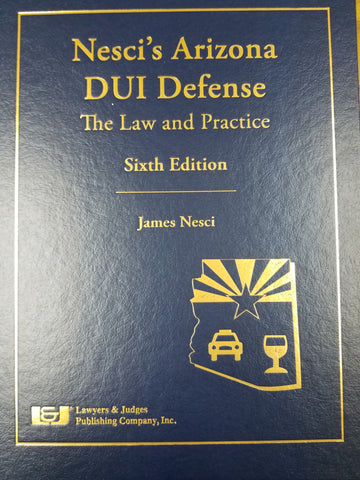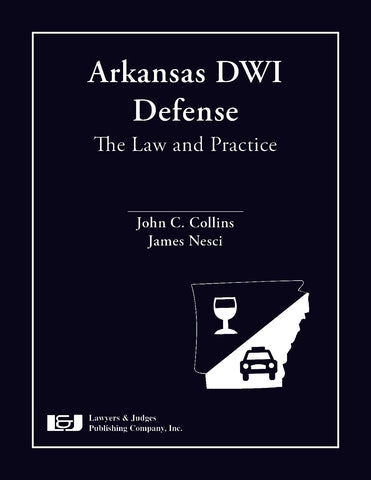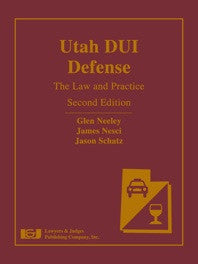
Utah DUI Defense: The Law & Practice with DVD, Second Edition
- Authors: Glen Neeley, James Nesci, Jason Schatz
- ISBN-10: 1-936360-19-5
- ISBN-13: 978-1-936360-19-2
- Copyright Date Ed: December 2, 2013
- Pages: 480 pages
- Binding Information: Casebound plus DVD
- Size: 8.5 x 11 inches (US)
For even the most seasoned attorney admitted to practice in the State of Utah, defending DUI cases has always presented special challenges. Today mounting a successful defense is more difficult than ever. Now you have the advantage with Utah DUI Defense: The Law and Practice, Second Edition. This text and supplementary DVD contains the most important information to help you attain a successful verdict.
Written by Glenn Neeley, James Nesci and Jason Schatz, all members of the National College for DUI Defense, Utah DUI Defense: The Law and Practice, Second Edition ensures that you understand the chemical, biological and technological concepts and issues underlying DUI prosecution and defense in the State of Utah. The authors provide the most up-to-date information available on key areas of DUI law in Utah including: DUI Investigations, Driving and Field Sobriety Testing, Drug Recognition, Evaluation and Chemical Testing, Blood Alcohol Calculations, Pre-trial Investigations and Motions, Practice, Plea Offers and Agreements, DUI Trial Procedures, and more.
Many practical tools and applications designed to streamline and simplify the complex DUI defense process have been developed along with this book. They are all included on a bonus DVD--so you can locate, review and print them out in a matter of seconds. The companion DVD contains NHTSA studies, articles and visual detection videos.
Lawyers & Judges has published twenty state-specific DUI defense reference books. A practitioner in Colorado raved in the Colorado Lawyer that Colorado DUI Defense: The Law and Practice is “a must-have resource” and would make “a nice gift for the lawyers in your life who practice DUI defense.” The Wisconsin Lawyer reviewer gave Wisconsin OWI Defense: The Law and Practice a touchdown review, calling the book “the best book I have read pertaining to Wisconsin operating-while-intoxicated (OWI) law, and one of the best in dealing with the substance of OWI law.”
Table of Contents
Table of Cases
How to Use This Book
Foreword
Chapter 1: Lawyer Advertising
1.1 Ethical Issues
1.2 Advertising Resources
Chapter 2: Client Relations
2.1 Meeting the Prospective Client
2.2 Client Intake Questions
2.3 Client Intake Interview
2.4 Retainer Agreements
2.5 Fees
2.6 IOLTA
2.7 Communication
2.8 Client Interview
Chapter 3: Driving Under the Influence
3.1 Misdemeanor DUI: The Ever-Changing Statute
3.2 Penalties for DUI
3.3 Prior Offenses in Misdemeanor and Felony Cases
3.4 Metabolite DUI
3.5 Ignition Interlock Device (IID)
3.6 Alcohol Restricted Driver
3.7 Homicide
3.8 Reckless Driving
3.9 Minor Driving with Alcohol in the Body
3.10 Sentencing: Statutory Scheme
3.11 Costs of Incarceration, Transportation, and Restitution
Chapter 4: Driver’s License Division
4.1 Overview
4.2 Implied Consent to Take a Chemical Test
4.3 Order of Suspension: Notice
4.4 DLD Hearings and Review
4.5 DLD Informal License Hearings
4.6 Revocation Hearing for Refusal
4.7 Borderline Refusal Cases (Inability to Give a Test)
4.8 Right to Attorney Prior to Taking Chemical Test
4.9 Implied Consent Suspension Utah Code 41-6a-520
4.10 Independent Test
4.11 Time Computations
4.12 Reinstatement
4.13 Minors and Juveniles
4.14 Suspension for Out-Of-State Violations
4.15 Validity of Out-of-State Licenses
4.16 Out-of-State Licensees
4.17 Appeals from District Court Decision
4.18 DLD Driver Points System
4.19 Commercial Driver License Disqualifications
4.20 Commercial Driver License Notification Requirements
4.21 Certified Ignition Interlock Devices (IID)
4.22 Expungement of DriverLicense Record (DLD)
4.23 Mandatory Revocation of Driver Licenses
Chapter 5: Pre-Trial Investigations
5.1 Overview
5.2 Visiting the Scene
5.3 Photography and Videos
5.4 Diagrams and Aerial Photography
5.5 Accident Reconstruction
5.6 Event Data Recorders (Black Boxes)
5.7 Roadblock (a.k.a. "DUI Checkpoint") Investigations
5.8 Pre-Trial Interviews
Chapter 6: Pre-Trial Motions Practice
6.1 Overview
6.2 Procedural Motions
6.3 Substantive Motions
6.4 Motions in Limine
6.5 Evidentiary Hearings
Chapter 7: Plea Offers
7.1 Overview
7.2 Waiver of Rights
7.3 Collateral Consequences
7.4 Exposure of Prior Offenses
7.5 Immigration Consequences
7.6 Misdemeanor Plea Offers
7.7 Felony Plea Offers
Chapter 8: Trial
8.1 Overview
8.2 Voir Dire and Jury Selection
8.3 Jury Instructions
8.4 Opening Statements
8.5 Cross-Examination
8.6 Direct Examination
8.7 Closing Argument
8.8 Sentencing
Chapter 9: DUI Investigations: Driving and Field Sobriety Testing
9.1 Overview: National Highway Traffic Safety Administration (NHTSA)
9.2 Driving Behavior
9.3 Standardized Field Sobriety Testing (SFST) Validation Studies
9.4 Legal Analysis and Summary of the SFST Validation Studies
9.5 Standardized Field Sobriety Test Battery
9.6 Horizontal Gaze Nystagmus (HGN)
9.7 Correlation Between BAC and HGN or FSTs
9.8 One-Leg-Stand
9.9 Correlation Between BAC and HGN or FSTs
9.10 Commonly Used Non-Standardized/Validated Field Sobriety Tests
Chapter 10: Drug Recognition Evaluation
10.1 Overview
10.2 DRE Statutory Law
10.3 Per Se Statutes Comparison
10.4 Impairment Statutes Comparison
10.5 Utah DRE Laws
10.6 Defenses
10.7 Implied Consent Laws Comparison
10.8 DRE Case Law
10.9 The 12-Step DRE Protocol
10.10 Deconstruction and Analysis of the 12-Step DRE Protocol
10.11 Effects of Various Drugs
10.12 Drug Evaluation Classification Protocol (DECP)
10.13 Drug Evaluation Classification Training Program
Chapter 11: Chemical Testing
11.1 Preliminary Breath Testing
11.2 Law
11.3 Safeguards
11.4 Commonly Used PBT Devices
11.5 Understanding Henry’s Law and the Blood to Breath Ratio
11.6 Evidential Breath Testing
11.7 Infrared Light Absorption
11.8 Basic Operation
11.9 Intoxilyzer Printouts
11.10 Breath Testing: Methods of Attack
11.11 Calibration
11.12 Utah Administrative Code R714-500
11.13 Statutory Requirements for Admissibility of Breath Test Results
11.14 Blood Testing: From the Vein to the Lab
11.15 Headspace Gas Chromatography
11.16 Blood Draws: Statutory Admissibility, Sample Preservation and Independent Testing
11.17 Secondary Blood Testing
Chapter 12: Blood Alcohol Calculations for Attorneys
12.1 Blood Alcohol Calculations for Attorneys
12.2 Determining the One-Drink Potential
12.3 Elimination and Retrograde Extrapolation
12.4 White’s Retrograde Extrapolation
12.5 Partition Ratio Conversions
12.6 Unit Conversions
Chapter 13: Expert Witnesses
13.1 Should I Hire an Expert?
13.2 What Type of Expert Do I Need?
13.3 Utilizing an Expert Witness Before Trial
13.4 Do I Need to Advise the Prosecutor I am Calling an Expert Witness?
13.5 Pre-Trial Preparation
13.6 Direct Examination of the Defense Expert Witness
13.7 Cross of the State’s Expert Witness
13.8 Direct Examination of the State’s Expert as a Defense Witness
Chapter 14: DUI Jury Trial Warpack
14.1 Actual Physical Control (APC)
14.2 Felony DUI
14.3 Appeals
14.4 Arrest
14.5 Authentication
14.6 Blood Draws
14.7 Breath Testing
14.8 Burden of Proof
14.9 Chain of Custody
14.10 Circumstantial Evidence
14.11 Closing Arguments—Ethical Considerations
14.12 Collateral Estoppel in DUI Cases
14.13 Comment of Defendant’s Silence
14.14 Confrontation
14.15 Corpus Delicti Rule Overuled
14.16 Amending the Information on the Day of Trial
14.17 Credibility of Witnesses
14.18 Destruction of Evidence
14.19 Discovery and Rules 14, 16
14.20 Directed Verdict
14.21 Double Jeopardy
14.22 DRE: Drug Recognition Evaluation Admissibility
14.23 Due Process
14.24 Evidence
14.25 Expert Witnesses
14.26 Field Sobriety Test Admissibility
14.27 Foundation
14.28 Suppression of FST
14.29 Impeachment
14.30 Independent Test
14.31 Jurors and Jury Selection
14.32 Jury Deliberations
14.33 Jury Instructions
14.34 Jury Trial Right
14.35 Motions
14.36 Miranda
14.37 Necessity Defense
14.38 DLD
14.39 Opinion Testimony
14.40 Entry of Plea to Lesser Offense
14.41 Prior Convictions
14.42 Probable Cause
14.43 Reasonable Suspicion
14.44 Record Preservation for Appeal
14.45 Refusal to Submit to Chemical Testing
14.46 Relation Back
14.47 Replicate Testing
14.48 Restitution
14.49 Right to Counsel
14.50 Roadblocks (a.k.a. “DUI Checkpoints”)
14.51 Rule 25 of the Utah Rules of Criminal Procedure
14.52 Searches
14.53 Sentencing
14.54 Subpoena
14.55 Voir Dire
14.56 Voluntariness of Statements and Trustworthiness
14.57 Warrants
Appendix A: Utah Rules of Professional Conduct Rule 1.5 Fees
Appendix B: Utah Rules of Professional Conduct Rule 1.15 Safekeeping Property
Appendix C: Utah Rules of Criminal Procedure
Appendix D: Utah Rules of Evidence
Appendix E: Modern Day Salem Witch Hunts
Appendix F: The Aging Process and Field Sobriety Tests
Appendix G: Fear and DWI Field Sobriety Tests

